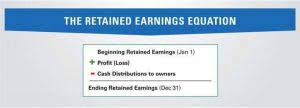
Reinvesting profits back into the company can help it grow and become more profitable over time. A second situation in which an adjustment can be entered directly in the RE account and, in this way, bypass the income statement retained earnings adjusting entry is in the context of quasi-reorganization. To naïve investors who think the appropriation established a fund of cash, this second entry will produce an apparent increase in RE and an apparent improved ability to pay a dividend.
- Retained earnings could be used for funding an expansion or paying dividends to shareholders at a later date.
- To calculate RE, the beginning RE balance is added to the net income or reduced by a net loss and then dividend payouts are subtracted.
- Closing inventories were overvalued as at 31 December 2007 by $2 million.
- Occasionally, accountants make other entries to the Retained Earnings account.
- For example, a company performs landscaping services in the amount of $1,500.
- Here are the ledgers that relate to the purchase of supplies when the transaction above is posted.
Adjusting Entries
Shareholders equity—also stockholders’ equity—is important if you are selling your business, or planning to bring on new investors. In that case, they’ll look at your stockholders’ equity in order to measure your company’s worth. Changes in the composition of retained earnings reveal important information about a corporation to financial statement users. A separate formal statement—the statement of retained earnings—discloses such changes. Now that we have defined both types of deferrals let’s discuss the journalized entries for prepaid expenses and deferred revenue. Essentially, when an accountant journalizes an entry in the books, they will ensure that it follows accrual-basis accounting.
Get Your Questions Answered and Book a Free Call if Necessary
The construction company will need to do an adjusting journal entry at the end of each of the months to recognize revenue for 1/6 of the amount that will be invoiced at the six-month point. On one hand, high retained earnings could indicate financial strength since it demonstrates a track record of profitability in previous years. On the other hand, it could be indicative of a company that should consider paying more dividends to its shareholders. This, of course, depends on whether the company has been pursuing profitable growth opportunities. Any item that impacts net income (or net loss) will impact the retained earnings. Such items include sales revenue, cost of goods sold (COGS), depreciation, and necessary operating expenses.

Unit 14: Stockholders’ Equity, Earnings and Dividends

This means $150 is transferred from the balance sheet (asset) to the income statement (expense). The balances in the Supplies and Supplies Expense accounts show as follows. For example, a loan contract may state that part of a corporation’s $100,000 of retained earnings is not available for cash dividends until the loan is paid. An adjusting journal entry is an entry in a company’s general ledger that occurs at the end of an accounting period to record any unrecognized income or expenses for the period. When a transaction is started in one accounting period and ended in a later period, an adjusting journal entry is required to properly account for the transaction.
- Accounts Receivable increases (debit) for $1,500 because the customer has not yet paid for services completed.
- The company wants to depreciate the asset over those four years equally.
- In a traditional accounting system, adjusting entries are made in a general journal.
- Each month that passes, the company needs to record rent used for the month.
- The same adjusting entry above will be made at the end of the month for 12 months to bring the Prepaid Insurance amount down by $100 each month.
- The IRS has very specific rules regarding the amount of an asset that you can depreciate each year.
Additional Paid-In Capital
- The same adjusting entry above will be made at the end of the month for 12 months to bring the Prepaid Taxes amount down by $100 each month.
- Accrued revenues are revenues earned in a period but have yet to be recorded, and no money has been collected.
- The remaining $11,000 in the Prepaid Rent account will appear on the balance sheet.
- During the year, the company generated net income of $8 million and declared dividends of $5 million.
- It is not worth it to record every time someone uses a pencil or piece of paper during the period, so at the end of the period, this account needs to be updated for the value of what has been used.
All such information is provided solely for convenience purposes only and all users thereof should be guided accordingly. 11 Financial is a registered investment adviser located in Lufkin, Texas. 11 Financial may only transact business in those states in which it is registered, or qualifies for an exemption or exclusion from registration requirements. 11 Financial’s website is limited to the dissemination of general information pertaining to its advisory services, together with access to additional investment-related information, publications, and links. Retained earnings are reclassified as one or more types of paid-in capital under two general circumstances. A fourth reason for appropriating RE arises when management wishes to disclose voluntary dividend restrictions that have been created to assist the accomplishment of specific organizational goals.

Risk management principles: Understanding ISO 31000 and COSO ERM

Adjust the accounts to reflect the organization’s correct financial position when errors occur in the accounts in subsequent periods. This is in accordance with generally accepted accounting principles fairness and transparency requirements for the presentation of accounts. If these adjustments affect the retained earnings account, the account must be adjusted by decreasing or increasing (debiting or crediting) the account. For example, if an expense item was not recorded in the previous period, the accountant must create a journal entry that debits the retained earnings account and credits the applicable expense account. Opening retained earnings are adjusted for any changes in accounting policies and accounting errors. Since comparative income statement is presented for only one year, changes to prior period revenue and expenses are reflected in opening retained earnings.
- If these adjustments affect the retained earnings account, the account must be adjusted by decreasing or increasing (debiting or crediting) the account.
- At the end of accounting period, the profit or loss from the income statement will move to the retained earning which is the equity component on the balance sheet.
- Not every transaction produces an original source document that will alert the bookkeeper that it is time to make an entry.
- For the two additional work days in June, the 29th and 30th, the company accrued $400 additional in Wages Expense.
- Hence, the retained earnings account will increase (credit) or decrease (debit) by the amount of net income or net loss after the journal entry.
- Cash-basis accounting involves companies recording revenue when they receive cash and expenses when they pay out money.
- Retained earnings are important because they can be used to finance new projects or expand the business.
